The water slithered up while the people went to sleep. No text alerts. No sirens. Just the Lumber River, the color of black tea, carrying out its slow, silent ambush, creeping up to the steps of the Baptist church and the rototillers at the hardware store and the 99-cent greeting cards in the pharmacy.
In her final hours in the home where she grew up, 55-year-old Bonnie Savage pulled a load of warm clothes from the dryer and folded them. She was hardly concerned about Hurricane Matthew. It had come ashore in South Carolina as a category 1 and was a tropical storm by the time it tumbled inland and into her hometown of Fair Bluff in eastern North Carolina.
Before that night – 8 October 2016 – the only major flood in Fair Bluff came in 1928, courtesy of the Okeechobee hurricane. Hurricanes, most people in Fair Bluff believed, were problems for people who lived at the beach. Climate change, they often thought, was hogwash. Most of the 1,000 or so people in Fair Bluff had never seen more than ankle-deep puddles in their streets. No way, they believed, could Matthew drop 13 inches of rain that weekend and leave 71 of their homes uninhabitable.
Certainly it couldn’t happen again just two years later with an even more brutal storm named Florence.
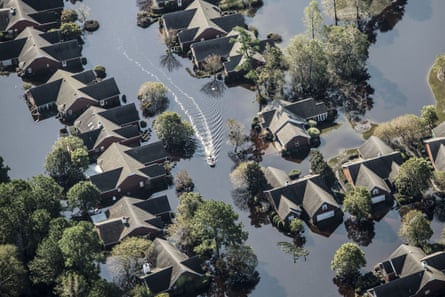
Often, floods stir images of water rushing recklessly through communities. But in the flat coastal plain of North Carolina, where sandy soil has been shifting since it was ocean floor 100m years ago, water is slow to rise and recede. The floods that followed Matthew and Florence in 2018 left Fair Bluff’s downtown underwater for more than two weeks each time.
Now, as the 2019 hurricane season begins, few communities have more to lose than this one. If another arrives this year, Fair Bluff could become one of the US’s first climate crisis ghost towns.
Officials want to rebuild a new downtown on higher ground, but they don’t have the money. Downtown is vacant now and Fair Bluff’s population has dropped by half to 450. They’re racing to get people back into homes before 2020 US census, or else they will face significant reductions in state and federal funding.
All this seemed unfathomable the night Matthew hit as Savage folded her laundry. And as 40-year-old Jimmy Moore parked his white Saturn View next to the plum tree in his backyard after finishing his work shift sorting sweet potatoes. And as former mayor Randy Britt told his wife they should stop by their hardware store in the morning. And as Ray Lundy, the retired minister of the Fair Bluff Baptist church, planned to meet his daughter at her pharmacy after sunrise.
But the next morning, 9 October, dozens of Fair Bluff residents woke up and put their feet down in the river beside their beds that Matthew had brought.
Moore saw the water over the hood of his Saturn. Britt and his wife waded thigh-deep through their hardware store. Lundytook a boat to his daughter’s pharmacy. He saw a pack of diapers float out. His eyes followed them, leading to a string of goods flowing down the street.
“There goes Fair Bluff,” Lundy said.
For Savage, sheltering elsewhere, the bad news came from a neighbor.
“Your house is underwater,” he called to tell her.
“You got to be kidding,” she said. “My house ain’t underwater.”
“Bonnie,” her friend said. “Your house. Is under. Water.”
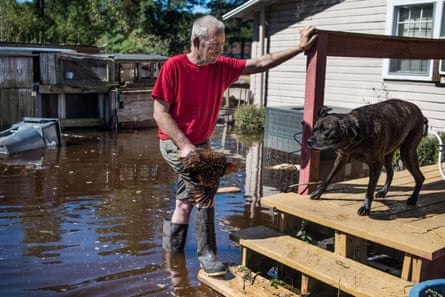
On a weeknight this June, Fair Bluff’s mayor, Billy Hammond, watched people stare at a board with the instruction: “Please pick three descriptive words that describe Fair Bluff’s future.”
For Hammond, who moved here as a child in 1959, the first indication that Fair Bluff would never be the same after Matthew came via a 5am call from the police chief.
“Your town is flooded,” the chief said.
Those words are now familiar to officials across eastern North Carolina. Matthew caused nearly $5bn worth of damage. Twenty-three months later, Florence dropped a record 8tn gallons of water, washing out 200 North Carolina roads, making instant islands across the state . More than 2,500 people were rescued, and 15,000 needed emergency shelter. Forty died.
In the past century, North Carolina has endured 15 major storms. The three worst, in terms of cost of damage, have occurred in the past 20 years – Florence, Matthew and Floyd in 1999.
They have caused a shift in conversations about hurricane preparation.
Across the state, local governments are adopting new zoning measures to prevent construction in 100-year flood areas. Zurich Insurance conducted an extensive post-storm study that concluded the state needs to be more aggressive about buying out vulnerable properties. Thirty years from now, the report says, Wilmington, a city of 120,000 hit hard by Florence, can expect 70 days of sunny-day flooding each year.
“Imagine how bad it could be,” the authors wrote, “and plan for worse.”
Many former skeptics now concede the climate is changing.
“It’s real,” says Lundy, the longtime Baptist minister. “I’m 76, and I’ve never seen any storms like that.”
Not everyone, though.
Evelyn Waddell stared at the board with the question about Fair Bluff’s future and put marks next to three words: friendly, creative and hometown. She lives on Gapway Road, where four consecutive houses are abandoned. Her home made it through OK. Asked if she agrees storms will keep getting stronger, Waddell says: “Why would they? I hate to hear the negative.”
This disconnect creates tension in discussions about moving forward. Of the 17 words on that board about the future, the two most popular are “uncertain” and “challenging”.

Bonnie Savage asked a rescue worker to give her a boat ride to inspect her house the next morning after Matthew.
She had moved into the three-bedroom home with her parents when she was about 13. After her divorce in the early 2000s, she moved back. Her mother died in 2005, leaving her in the house alone. She liked the peace and quiet and independence.
Now she felt nauseous as she opened the door. The soaked floors were warped. Her mother’s china cabinet was ruined, and the 70-year-old pine bed was split down the middle. She wondered if she could save anything.
Then she saw the laundry basket, still up on the washer. Finally, a reason to smile.
She moved those clothes into her brother’s house and waited. Federal Emergency Management Agency (Fema) workers assessed damage. Rescue workers stayed as long as they could, but they couldn’t save her childhood home.
“Every time you turned around, somebody was giving out shovels and rakes and cleaning supplies,” Savage says. “And I’m like: ‘I don’t need no cleaning supplies! I need a house!’”
Savage moved in with her brother and waited for word on a new house. Throughout eastern North Carolina over the next year-plus, residents grew frustrated. The state had been declared a disaster area, but Fema funds were slow to arrive. While richer counties, like the one around Charlotte, already have aggressive buyout programs in flood zones, areas in the coastal plain can’t just shift cash like that. The Charlotte program pays about $100,000 a house; Fair Bluff’s total operating budget is just $660,000.

Now, with its tax base decimated, Fair Bluff’s only chance at survival is state and federal funding.
Savage’s home was one of 71 Fair Bluff applications approved by Fema’s hazard mitigation program in spring 2018. The only place to receive more approvals was Lumberton with 101. Lumberton is 20 times the size of Fair Bluff.
The town named a contractor, the Adams Company, as administrator of the $8m disaster mitigation funds. The company gave homeowners three options: have their vacated home bought at a pre-flood value, repair and elevate the home if it’s still structurally sound or build a new home and elevate it on the same land.
Savage chose the last option: new home, same land, higher.
On 30 August 2018, nearly two years after Matthew, Adams was completing its interviews with the 71 homeowners when a wave of tropical air emerged off the west coast of Africa.
Over the next week, the wave would become a storm and the storm would become a hurricane. Florence sized up North Carolina as a category 4 before wind shear weakened its gusts. Florence made landfall as a category 1 on 13 September and then stayed, and stayed, pumping water on the state like a firehose.
Every river in eastern North Carolina surged over its banks. The water topped fully grown cornstalks and left ocean fish lining interstates.
Three days after the rain stopped, Bonnie Savage and the other 71 people flooded out after Matthew watched the Lumber rise again, and rise some more.
For the first time in the 23 months since she lost her home, she cried.
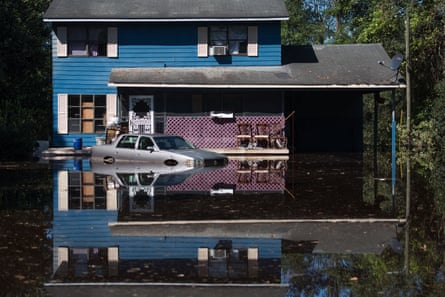
Jimmy Moore picks a plum off the tree in his yard and bites into it.
“Tart,” he says, making a face.
Moore lives on Gapway Road, the only one of Fair Bluff’s original roads that remains the same as when the town’s founders carved it out in 1811. He’s a few houses down from Waddell, the optimist from the meeting about Fair Bluff’s future. That’s another thing that makes Fair Bluff different: mosteastern North Carolina towns are deeply segregated. Here white people like Wadell and people of color like Moore are neighbors.
Moore’s parents bought the land in 1991. His dad, a bricklayer, built several pillars out front and topped them with concrete eagles. In one, he inscribed the date they moved in: 10 November 1991. Jimmy would have been about 15.
On the night Matthew came through, Jimmy shared the home with his brother and father. As the water climbed the steps, they called in a boat rescue. Unlike most of their neighbors, though, they had flood insurance. They were able to start the rebuilding process before waiting for Fema. They were back in a new, raised double-wide less than six months after the storm.
Today, as he picks plums, he’s two lots over from where a stretch of four consecutive vacant homes begins. One still has belongings from inside in a pile in the yard.
“This is the only town that’s not recovering from the hurricane,” Jimmy says. “It’s just like everything’s on halt. Everything’s stopped. But if you go into town they’ve got this big old town hall built.”
He’s talking about the biggest point of contention right now in Fair Bluff: the struggling town has a spanking new town hall.
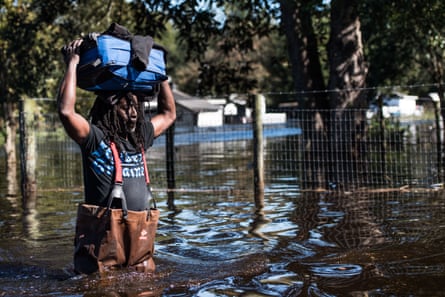
To understand how it got there, you have to go back. In the 1990s, 46 attorneys general reached a settlement with the country’s four largest tobacco companies on smoking-related illnesses. The payout, $206bn, was the largest civil litigation in US history. North Carolina, one of the biggest tobacco-producing states, established the Golden Leaf Foundation to manage its portion of the settlement. The foundation awards education and technology grants primarily to rural areas affected by the collapse of the tobacco industry.
Six months after Matthew, Golden Leaf awarded Fair Bluff about $1.75m to renovate and expand the town hall, police department and visitors’ center.
The buildings opened in the spring of this year, about six months after Florence, and with half of Fair Bluff’s population still displaced.
Officials say it’s critical to have a central building for a town, but they understand why some residents are upset. “They’re discouraged, and then they see this,” Paula Kempton, the town project manager, says, gesturing around her office in the new building. “Well, this is theirs, too. This represents that Fair Bluff is still fighting to stay here to make sure they have a town for their people.”
To the regular resident money is money, and they don’t see why it wasn’t spent on their homes. Many don’t have time to wait.
Fair Bluff’s average age is about 55, making it the oldest in Columbus county. Hammond says he has seen an increase in heart-related illnesses and deaths, which he attributes to stress.
But few want to leave. Jimmy now lives in the new home with an older brother. Their father died in the house in October 2017. A water mark runs across the doorknob on his shed. That’s from Florence, he says. Thankfully, for that storm, his new home was elevated.
Jimmy is puzzled at any suggestion about moving out of Fair Bluff. He can walk down the street and fish any day he wants. He keeps a garden in the same place his dad kept one. Mustard greens and okra are coming up now. There’s something about this land.
“Daddy was born and raised here,” Jimmy says. “Unfortunately, he died last year, but he got his dream to come back to Fair Bluff, because he loved it so much.”

At 10.05am on a Thursday this June, Bonnie Savage slaps a beef patty on a flattop grill at Johnny’s restaurant on Main Street. It’s only a quarter-mile walk to downtown from here, but Johnny’s didn’t flood in either storm. Now it’s one of only a handful of places still open most days.
Savage, for all she’s been through, remains upbeat. She has worked at Johnny’s as the only full-time waitress for nearly a dozen years. It’s the best job she has ever had. Pictures of regulars decorate the walls. In Fair Bluff, where the population is more than 60% black, the shots show a colorful mix of faces.
There are signs of construction around town, but good news is slow. Fair Bluff’s largest employer, Ply Gem, which makes vinyl fencing, recently announced it will close, resulting in about 60 to 70 layoffs. “We will have what you might say is no industry here,” says Britt, the former mayor.
Most areas east of Interstate 95 in North Carolina are adjusting to two new realities. First, the farming industry has changed dramatically, with the tobacco all but gone and big agriculture companies soaking up profits from the pork and poultry growers. Second, hurricanes keep coming.
In Fair Bluff, I heard a question I have heard just about everywhere else I pull out a notepad in eastern North Carolina: “Are you gonna help us?”
Lundy, the retired minister, collected a couple of thousand dollars through the church last fall and went door to door with cash in envelopes: about $200 for single people, $400 for families with children. In one instance, he stopped a woman downtown and handed her $300.
“She put her head on my shoulder and just wept,” he says. “My shoulder was wet from her tears.”
When I ask Kempton, the town project manager, about Savage’s house, she knows immediately who I’m talking about. Kempton eats lunch at Johnny’s like everybody else. “I’ve not heard a good story since I’ve been here,” says Kempton, who came here after Florence on a two-year contract. “But Bonnie will be getting a house. And hopefully it’ll be enough to heal her.”
For Savage, it can’t come soon enough.
She lives with her brother and his two grown sons. The sons are 40 and 37, and she gripes about them not having a job in this town without jobs. She cooks for all of them each night after her shift at the restaurant.
She tells me that she has had more health problems in the past three years than in all her life. Doctors prescribed a steady stream of painkillers for a pinched nerve in her neck, but she hated how they made her feel, so she threw them away. Now, she says, she’s dealing with high blood pressure.
But why not just take the buyout and move to higher land just outside of town, away from the black-tea river? Hasn’t she heard that the storms are only going to get worse?
“I’m not even worried about the flood again,” she says. “I’m living in the here and now.”
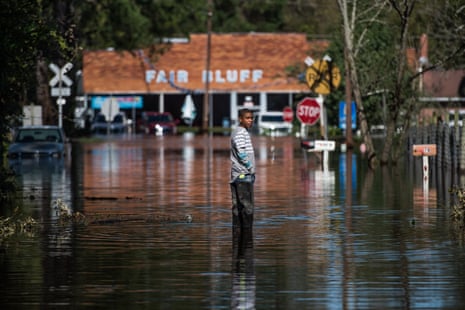
Comments (…)
Sign in or create your Guardian account to join the discussion